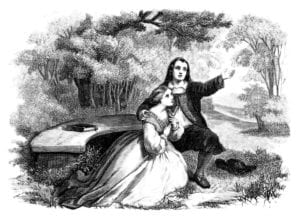Shakespeare’s Sonnets 91 - 108
Sonnet 91
Summary: some people take pleasure in their wealth or status, others in activities like riding and hunting – but the poet disdains such appetites and compulsions. Rather his “joy” lies in his relationship with the “fair youth”, marred only by the possibility that he may one day lose this and be reduced to misery.
Note: the sonnet has a simple structure. The opening six lines describe particular activities before generalising with the thought that there’s something for everyone. The next six lines (“But …”) draw the anticipated comparison with a direct address to the youth (“Thy love is better ….”) before the “wretched” alternative is faced.
Question: how convincing do you find the poet’s rejection of status, wealth and pastimes in this poem?
Sonnet 92
Summary: the poet believes that to be abandoned by the “fair youth” is to die. So he has no need to feel anxious, since either he enjoys his love or he dies. But what (asks the poet) if the youth “be false” and has rejected him but has not yet informed him?
Note: the poet’s relationship with the youth is described in terms borrowed from the lexical field of property – the youth may “steal thyself away”, though he is “assured mine”, to whom “a better state belongs”, in short “a happy title” [or entitlement]. A “term of life” incidentally may indicate either property – or marriage.
Question: how persuasive do you find the thrice-repeated adjective in lines 11 and 12?
Sonnet 93
Summary: the poet cannot know whether he is being deceived by the “fair youth” because his appealing looks, evoking thoughts of “sweet love”, cannot be read dependably. Others may be easier to interpret, but the youth, even if he is not to be trusted, seems as irresistible as the apple in Genesis.
Note: the poet’s attention moves as the poem progresses from his own doubts to focus more narrowly on the “fair youth” – a progression reflected (as often in these poems) in the pronouns: at first “I” and “thou” are referenced equally; in the last six lines the genitive pronoun “thy” appears eight times.
Question: how far do you agree that the opening word of this sonnet refers to Sonnet 92?
Sonnet 94
Summary: self-restraint matters, to be admired and praised, so it is not enough simply to be as attractive as the “fair youth”: “nature’s riches” must not be expended profligately. After all, a flower in summer may be beautiful, but if it founder “with base infection”, it is less use than the “basest weed”.
Note: the poem’s first eight lines explore what might be called a moral generalisation, suggesting that those who look virtuous have a special obligation to act accordingly. The closing six lines reinforce this credo with an analogy drawn from nature: flowers that are beautiful but corrupt (or infected) are particularly offensive.
Question: how convincing do you find the closing six lines as a means of reinforcing the opening eight?
Sonnet 95
Summary: even the shortcomings of the “fair youth” are “sweet and lovely”, though the poet is conscious that his physical attractiveness may disguise a multitude of sins, “vices” concealed behind “beauty’s veil”. He encourages himself (or perhaps the youth) to recognise that beauty is itself time-limited – as, perhaps, is deception.
Note: the poet explores a range of metaphors here. Initially he returns to the rose, a symbol of femininity in much of his work. Next, after a brief allusion to taste (“sweets”), he glosses the youth’s appearance as “a mansion”, before closing on a somewhat more chilling image: the “hardest knife”.
Question: how has the poet’s mood changed in this sonnet compared to the previous three?
Sonnet 96
Summary: the poet believes that “faults” are easily framed as “graces” in one so attractive as the “fair youth” – like a cheap jewel “on the finger of a queen”. This gives the youth the power to mislead admirers but the poet hopes he will not use it, not least because it will rebound on himself.
Note: the poet strikes a critical note in this sonnet, referencing “thy fault” in line one and “those errors that in thee are seen” in line seven. The implication is that the youth is part of a coterie – the court perhaps – becoming sceptical of his conduct – though still drawn to his attractions.
Sonnet 97
Summary: the poet regrets that throughout the summer and early autumn, he has been separated from the “fair youth” – a separation that seemed like a version of winter. Indeed it is almost as if the familiar features of winter – the “mute” birdsong, the “pale” leaves – were the consequence of the youth’s absence.
Note: the poet personifies his experience of separation from the admired youth – the summer season, he says, though it gave birth to “abundant issue”, was nonetheless possessor of a “widow’d womb” in the youth’s absence, since “summer and his pleasures wait on thee”, and days seem wintry without him.
Question: the poet uses imagery drawn from the seasons. Which other lexical fields might serve his purpose?
Sonnet 98
Summary: the youth’s separation from the poet is particularly poignant “in the spring”, it seems, when “a spirit of youth” reinforces (rather than disguises) a sense of absence. Then the sound of birdsong and the sight and smell of flowers are no more than shadows evoking painful thoughts of the absent youth.
Note: the poet returns (with more precision, perhaps) to the extended metaphor of the seasons, in which the youth’s absence in spring is seen as ironic. The youth is represented as a “pattern” of flowers notable for their sensual appeal – their appearance and odour – though they are mere shadows of the young man.
Question: why do you think the poet uses the informal “thee” in 97 and the formal “you” in 98?
Sonnet 99
Summary: in 98, the poet recalls how he “did play” with a range of flowers while thinking of the absent youth. In 99, he explains this play, detailing how these flowers – the “forward violet”, the lily, some “buds of marjoram” and a number of roses – triggered memories of the youth that were not redeemed.
Note: sonnet 99, uniquely in Shakespeare’s sonnets, contains fifteen lines, opening with a five-line first verse whose rhyme pattern is ababa. The opening line enables the poet to contextualise his dramatic monologue, which begins with the vocative “Sweet thief …”. The closing couplet is a kind of summary for sonnets 97 – 9.
Question: what is the effect of the extended metaphor of crime (“thief … steal … stol’n … stol’n … theft … stol’n”)?
Sonnet 100
Summary: the poet regrets a recent lack of inspiration to write about life’s more important concerns, and calls on his muse to address what matters. Above all, the poet wonders whether his love looks as young as ever, craving to write the poems that will preserve him from Time’s ravages.
Note: the poet opens with two questions asking what has become of his Muse, before proceeding to a sequence of eight imperatives: “Return … redeem … Sing … Rise … survey … be a satire … make … Give”. This sonnet returns to the theme of literary immortality that underwrote the opening nineteen sonnets.
Question: to what extent is the hope in line 13 (“Give my love fame”) fulfilled by the sonnets?
Sonnet 101
Summary: the poet calls upon his Muse to inspire him to write about the beauty of the “fair youth”. In doing so he senses he will be told that beauty needs no embellishment or underlining. But, he counters, need is not the only criterion – the aim remains to record the youth’s beauty in poetry.
Note: the poet imagine a dialogue in which, initially, he regrets what he calls the “neglect” of his theme, which is the enduring beauty of the youth. He imagines the response he will receive – nothing can profitably be added on this subject – before recalling the original aim: to immortalise the “fair youth”.
Question: is this a poem about love? Or is it about beauty? How much do we learn about the youth here?
Sonnet 102
Summary: the poet admits that he may not seem as fulsomely in love as before, but he has no faith in those who advertise their affections wholesale. Rather he admits that he was most moved to write when his love was new, and now, to avoid repeating himself, he prefers to hold his tongue.
Note: the poet compares his song to that of Philomela, the mythical nightingale whose backstory is complicated and brutal. Essentially, the bird is a symbol of recovering powers of song after a violent assault has left her voiceless. The image recurs in Shakespeare’s plays in violent contexts.
Question: what evidence is there in the poem for the opening clause in line 1?
Sonnet 103
Summary: the poet believes his poems add nothing to the attractive appearance of the “fair youth”, thus leaving him disillusioned. Given that the poems aim for nothing other than “your graces and your gifts to tell”, the youth is advised to look in the mirror for evidence of his own beauty.
Note: this is the fourth sonnet in which the poet invokes his Muse to inspire him to write about the “fair youth”. A sense of failure to capture the youth’s attractions underwrites his advice to the youth to “Look in your glass” – the third time (after Sonnets 3 and 77) this advice has been given.
Question: how narrowly has the poet focused in recent sonnets on “your graces and your gifts to tell”?
Sonnet 104
Summary: the poet reassures the youth that he remains as attractive as when “first I saw you fresh”, three summers earlier. Yet he accepts that time creeps along imperceptibly, so it is possible that he “may be deceived”. Framed like this, all beauty – even that of unborn generations – is already doomed.
Note: the poet contrasts two methods of measuring time. In lines 1-8, the passage of the seasons is reflected in the changing appearance of “the forests”. In lines 9-12, a time-piece reflects the slow but inevitable passage of time. The poem closes with a reflection on the passing of time, whichever index is used.
Question: how does the poet resolve the apparent contradiction between the opening line and the closing couplet?
Sonnet 105
Summary: the poet asserts that the familiar (and repeated) themes of his sonnets reflect the constancy of his unchanging love. The spirit of these poems – “Fair, kind and true”, he says – offer “wondrous scope” for writing about the youth, reflecting the unique qualities of his love.
Note: the sonnet makes use of religious (specifically Christian, and Anglican) thinking, first in brushing off accusations of “idolatry” – worshipping false idols is an infringement of the first commandment – and later in ascribing a trinity of virtues to his verse, thus evoking the Holy Trinity.
Question: to what extent do you feel that this sonnet (and the Sonnets in general) are open to an accusation of idolatry?
Sonnet 106
Summary: the poet reflects on verses written long ago in praise of “ladies dead and lovely knights”, and sees in their detail the youth’s own beauty. As such, these poets merely anticipated the “fair youth”, though they may not have known this – not least the difficulty of adequately singing his praises.
Note: the poet’s lexical choices subtly reflect the thinking in this sonnet. Initially, reflecting on times past, his language comprises archaisms like “wights” [= people] and “blazon” [= list of virtues]. Later the poem focuses on the contemporary, with lexemes (for example the 15th century “prefiguring”) easier to associate with “these present days”.
Question: how far do the lexical choices here (“you master now” etc.) reflect the gender of the addressee?
Sonnet 107
Summary: I cannot tell the future, says the poet, and do not know how “my true love” will develop: indeed, he adds, many predictions have been made for the wider world, which have not materialised. At present, he believes, love seems “fresh” and death remote – and immortality may be secured in these poems.
Note: the poem is replete with words evoking the future: “fears … prophetic … things to come … lease … forfeit … doom … augurs … presage … Uncertainties …” etc. It is possible that this sonnet was written around the time of the death of Queen Elizabeth and the accession of James I (1603).
Question: the poem seems optimistic, almost effusive. Choose three further adjectives to describe it.
Sonnet 108
Summary: the poet reflects on his sequence of completed sonnets, and asks whether there is anything new to say. The answers is “Nothing, sweet boy”. But like saying his prayers, declarations of love are routine, not faded by age but triggered by the same instincts as “the first conceit of love”.
Note: extending his use of religious (specifically Christian) themes and lexemes from recent sonnets, the poet compares his poems to “prayers divine” and describes himself in his devotion to the youth as having “hallow’d” his name. There may be further religious references in “spirit” (l.2) and “eternal” (l. 9).
Question: based on the evidence in lines 6 – 14, how true is the answer he gives in line 5 to his initial questions?
One Hundred Word Endnote:
Shakespeare seems to have composed his 154 sonnets largely for private entertainment, circulated and appreciated among friends. Their existence was first revealed in a book by Francis Meres in 1598, and two were published in 1599, probably without their author’s permission.
The entire collection appeared in 1609, but there the certainties end. The identity of the dedicatee (“Mr W.H.”) is disputed, and anyway he is not necessarily the subject of the poems; at least two lovers are addressed, and probably more than two; and it is highly unlikely the poems were written in the order in which they are printed.




